The Details Make All The Difference Between Bourbon And Scotch
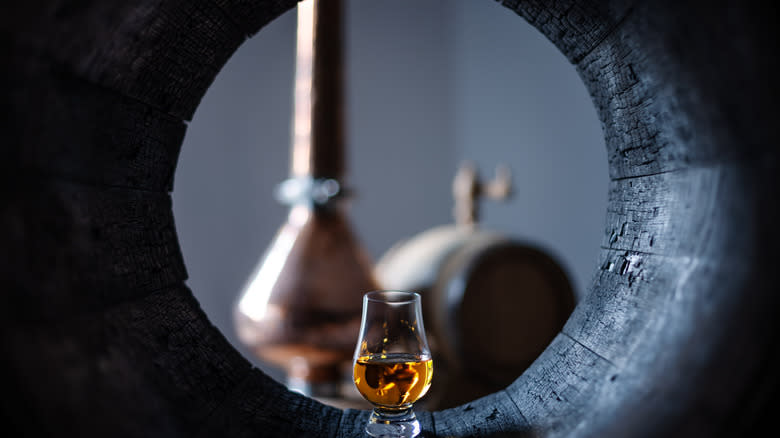
Whiskey is a surprisingly complex part of culture. You can find it fueling a college frat party, swirling in the glass of a barfly, or adorning a wealthy CEO's office in a crystal decanter. Just as varied as its many social roles are the categories of whiskey you can buy. Oftentimes, whiskey is categorized by region. There's American whiskey, Irish whiskey, Japanese whisky, and so on. Within these regional categories are subcategories (and sub-subcategories).
The whole thing gets complicated quickly, and it's easy to get lost in the weeds as many whiskey nerds love to do. But, if you take a step back from the granular details, there's a general structure that's easily identifiable, even by people who don't drink whiskey. Two of the most iconic types of whiskey that nearly everyone would be able to name are bourbon and scotch. Ask people to explain the difference, though, and you'll likely get blank stares from everyone but the bartender.
Understanding the difference between bourbon and scotch isn't all that hard once you learn a few fundamentals about how whiskey is made. Modern whiskey is currently undergoing a revival with an emphasis on craft and quality, so diving deep into what craft distillers are up to can be a lot of fun, but it isn't necessary to start in the deep end to appreciate this age-old spirit.
Read more: The 25 Best Bourbon Brands, Ranked
What Is Bourbon?
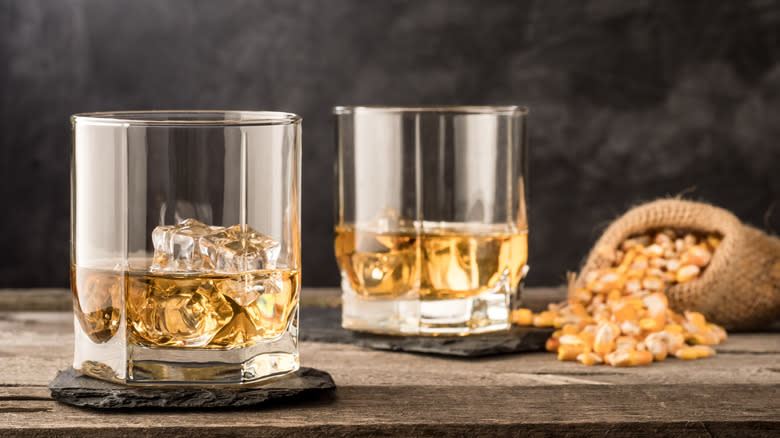
Bourbon is an American whiskey; and the most successful type of American whiskey at that. It originated with pioneers looking to make quality liquor using the abundant amounts of corn being grown in the American Midwest. The legend would have it that Elijah Craig was crowned the father of bourbon, but the title is widely disputed. Craig was a successful Baptist minister who was the 18th-century version of famous and, although he was likely one of the first bourbon distillers, his lasting legacy likely boils down to simply being more well-known at the time than the true inventor of bourbon, whoever that may be.
Bourbon is recognizable by its sweetness, thanks to the corn, and it has undergone a renaissance in the past few decades. Arguably beginning with the 1984 release of Blanton's, the world's very first single-barrel bourbon, the spirit has since climbed its way up to the very highest shelves in the bar. There's a whole world of craft bourbon blooming before our eyes, albeit out of the reach of most people's bar budgets. This is all to say that bourbon is no longer simply a poor man's whiskey but can compete with the best of them.
What Is Scotch?
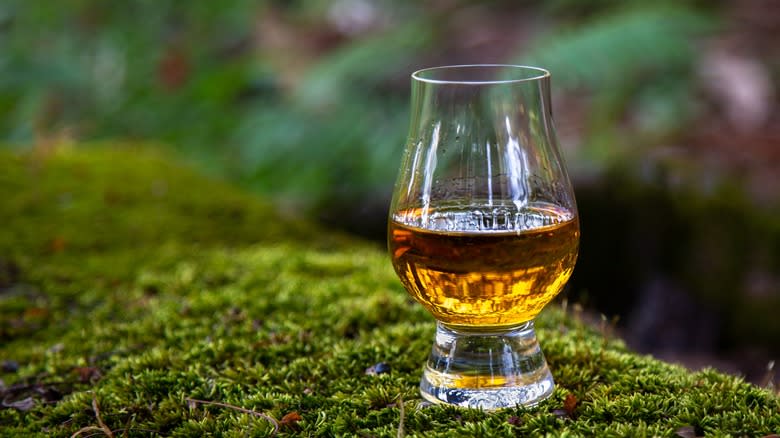
Scotch hails from Scotland, as you may have guessed, and can only be called such if it's made in Scotland. There are five different types of scotch, which are identifiable primarily by what kind of ingredients they use. Some use malt, some grains, and then there are blends. When you spell whiskey in the context of scotch, be sure to drop the 'e' – as in, scotch whisky.
This history of scotch is as old as the history of whisky itself. The first written record of whisky production dates back to the Scottish Exchequer Rolls of 1494, which detail the purchase of a large quantity of malt for the Scottish king. Although he may not have followed the exact requirements we use for Scotch today, it's safe to say that the very first record of whiskey was of scotch whisky.
One unique aspect of scotch is that it is often peated, which provides its characteristically smoky flavor profile. Peat is the compressed organic matter that sits on top of bogs and marshes. The distiller takes the peat and burns it, allowing the smoke to waft over the barley or grain. Peat is a nonrenewable resource and is becoming more difficult to acquire, so some distillers have begun to use other methods to achieve the smokiness. It should be noted that not all scotches are peated and not all smoky whiskeys are scotch, but it is typical of the region.
The Mash Bill Matters, Maybe
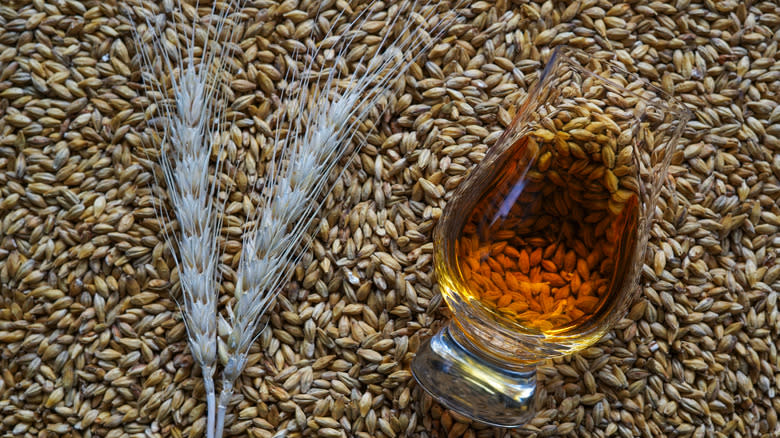
If you set out to make bourbon and scotch side by side, the first thing you'd notice is that your grocery list would be different. A mash bill is essentially the recipe that stipulates which ingredients are used to distill the whiskey. Bourbon is legally required to be at least 51% corn. Typically, bourbons contain about 70% corn, and the rest is up to the distiller. Many bourbons use a combination of rye and barley, but there are exceptions, such as wheated bourbons, which substitute the rye for wheat, resulting in a sweeter, less spicy spirit.
Although scotch allows for a variety of grains to be used, barley is by far the most common. Roughly 90% of all scotch produced is a blend of malt and other grains, but single malts (read malted barley) are some of the most prized and expensive kinds of scotch on the market. Interestingly, the Scottish don't use mash bills in the same way that Americans do. With a single malt or single grain, there's no mash bill because it's only one ingredient. With blends, the malt is distilled in one location and the grain is distilled in another, then they're blended when they're done. Explaining why this matters would take a while — suffice it to say that it doesn't leave much room for the concept of a mash bill to be useful.
Barrels Of Flavor
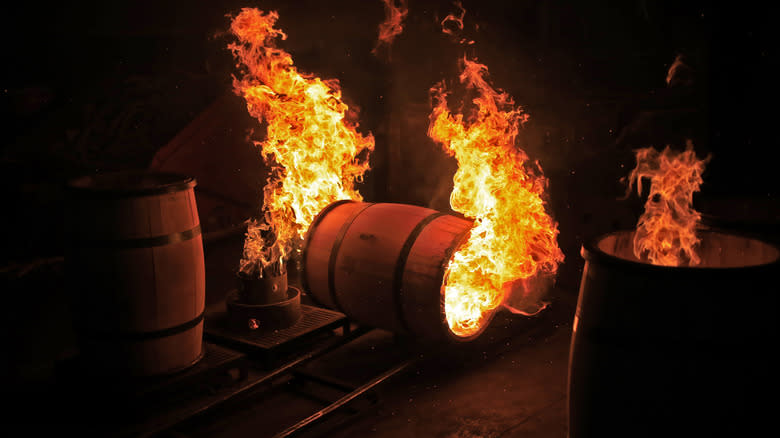
Apart from the ingredients, the most important stage of the distillation process is how the whiskey is aged. Most bourbons use American oak for their barrels, though it's not legally required. What is required is that the barrel is new, meaning it's never been used to age a spirit before. Not only that, but it has to be charred. After the barrel has been assembled, an open flame is used to turn the interior surface of the barrel into a thin layer of charcoal. Some distilleries will subvert this requirement by toasting the barrel instead, which heats the interior without getting it hot enough to form charcoal. Once the bourbon has been placed in the barrel, it must be aged for at least two years. There are subcategories that have other requirements, such as the bottled-in-bond bourbons, which require four years.
Scotch must be aged for a minimum of three years, though many distillers age their product for much longer. By and large, scotch producers use old bourbon barrels to age their whisky. The fact that they're the same barrels means both bourbon and scotch are going to be receiving similar flavor notes from the wood. But, since scotch gets a used barrel, the flavors are going to be softer than in bourbon. That's probably a good thing since scotch gets a sharper flavor from its barley relative to the sweet corn of bourbon.
The Strength Of A Spirit
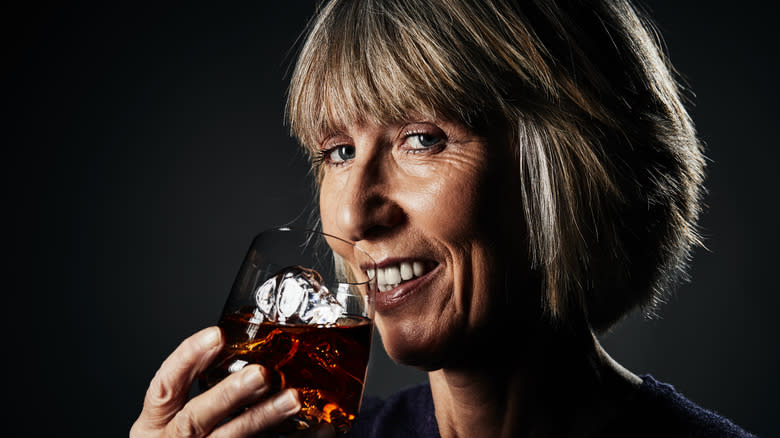
If you've ever shopped for alcohol before, you've likely noticed that the proof of the alcohol is almost always listed on the label. It may seem like the only reason you would need to know that is to gauge how drunk you are going to get from it, but the proof of a spirit has a huge impact on flavor as well. Within each category, there is a huge range of alcoholic proofs with differences between them. In case you didn't know, the proof is double the alcohol content. So a 100-proof whiskey is 50% alcohol.
Bourbon is legally required to be a minimum of 80 proof but can't be more than 160 proof. Preferences will differ, but as a general rule of thumb, higher-proof whiskeys tend to have more flavor. There are certainly exceptions, but craft bourbons are rarely below 100 proof, while high-proof bourbons rarely reach above 140 proof, even though 160 is the limit.
Scotch is typically between 80 and 92 proof, with high-proof scotch rarely if ever topping 120 proof. This is partly a preference, but it also has to do with alcohol evaporation during the aging process. Scotch is usually aged for longer than bourbon, and with each passing year, alcohol evaporates into the air. Distillers call this the angel's share, and it keeps scotch from being able to compete with the high-proof bourbons — not that it needs to.
Read the original article on Tasting Table.

